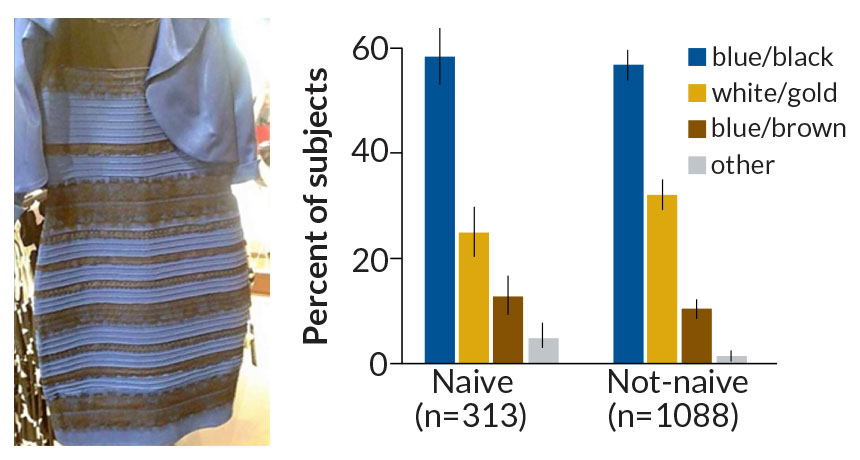The Dress divided the Internet, but it’s really about subtraction

Regardless of whether people had seen the picture of “the dress” previously (naïve versus not naïve), perceptions of its colors fell cleanly into two blue/black or white/gold camps, with a handful of respondents seeing blue/brown.
Dress: Reproduced with permission from Cecilia Bleasdale; graph: R. Lafer-Sousa et al/Current Biology 2015
- More than 2 years ago
It was the dress that launched a million tweets. In February, a mother-in-law-to-be sent a picture of a dress she was considering wearing to her daughter Grace’s wedding to Grace and her fiancé. The couple couldn’t agree on the dress’s color: was it blue and black or white and gold? (White and gold, obviously.) The disagreement prompted the daughter to post the picture on social media, recruiting other opinions. That post caused such a stir that BuzzFeed picked it up, asking the masses to weigh in.
And then the Internet went haywire. Within a few days, the original BuzzFeed article had more than 37 million hits. Serious news outlets interviewed neuroscientists and psychologists about color perception and optical illusions. Bevil Conway, a neuroscientist at Wellesley College, was one of those scientists. At the time, he thought the hullabaloo was interesting mostly because it showed how passionately people feel about color (as in, insanely riled-up and deeply offended by alternative views). He joked with NPR’s Robert Siegel, off air, that the story was “fluff,” Conway told me.
Well, there’s nothing like a little research to turn fluff into gold (or blue or black). Conway, coauthor of a study appearing online May 14 in Current Biology that explores people’s perceptions of the dress, now calls the phenomenon “profound.”
“I think it will go down as one of the most important discoveries in color vision in the last 10 years,” Conway says. “And all because of a crazy photograph.”
In those February interviews, Conway (and some other scientists) explained the disparity of opinions on the dress in terms of “color constancy,” a feature of perception that allows us to identify colors under different lighting conditions. If we see a red poisonous snake or a red delicious apple, we need to be able to identify it as red (and dangerous or delicious), whether in bright sunlight or the gloom of clouds. So when we see things in daylight, for example, our brains are pretty good at subtracting the contaminating blue of the sky in our color calculation, allowing us to see the “real” color. In other situations, such as a room illuminated by warm incandescent light, our brains try and remove that orangey-yellow glow.
The actual dress is royal blue and black, and color analysis of the photo of the dress shows it as light blue and brown. So people who were seeing the dress as white and gold were subtracting that blue sky bias from the blue stripes in the photo (making them white) and from the brown stripes (making them yellow). People who saw it as blue and dark gray (black) were subtracting orangey-yellow from light blue and brown, yielding dark blue and dark gray. This made sense, especially because there are so few cues in the photo — no skin color or other objects — without which the brain has to invoke a hefty dose of prior experience to interpret the color.
What Conway didn’t anticipate was that people would match the colors they saw to standardized versions of those same colors. After much discussion in his lab about what was going on with the dress, his team did an experiment where they showed more than 1,000 people a picture of the dress with two arrows, one pointing to each stripe. Participants then were asked match the color they saw with one on a standardized pixel palette. Strikingly, the picks fell cleanly into the two camps that had set Twitter on fire. (There was one small third clump that saw the dress as blue/brown, the color of the pixels the camera assigned the dress.)
To some people, the dress really was white and gold. For others, it was actually blue and black. The two color camps suggest that the brain may deal with color ambiguity in a similar way to how it deals with optical illusions, such as the Necker cube (which pops out or recedes) or Rubin’s vase (or face), in which the brain resolves ambiguity by settling on one interpretation of what it is seeing.
“We thought that everyone would resolve the colors in the same way,” Conway said. “But the extent to which people see the same physical thing as different is far greater than I ever imagined.” The study suggests that our internal models shape color perception far more than has been recognized.
And when the scientists dug into the data, they also found that Conway’s casual speculation from a February interview, “I bet night owls are more likely to see it as blue-black,” may have merit. Compared with men and young people, women and older people are less likely to be night owls, research suggests. And women and older people were more likely to see the dress as white and gold, the researchers found.
It isn’t known whether this night owl versus daytime bias develops over a lifetime or is influenced on shorter time scales such as months — there’s evidence that people who have yellow cataracts removed from their eyes experience a change in color perception that normalizes with time. But it does suggest when it comes to color perception, as with other senses, the brain relies considerably on prior experience.
“I take much more seriously that ‘do you see red like I see red?’ epiphany we have when we are teenagers,” Conway says. “It turns out that under some circumstances the answer is unequivocally, no.”







